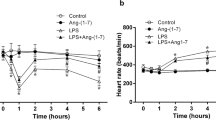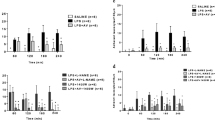Abstract
Objective
We examined whether activated protein C (APC) treatment improves cardiovascular inflammation and dysfunction in endotoxemic rats.
Design and setting
Randomized, controlled trial in an experimental laboratory of a university physiology department
Subjects
Male Sprague Dawley rats.
Interventions
Internal carotid artery and external jugular vein were catheterized under sterile conditions in rats. Instrumented rats infused or not with APC (240 μg/kg per hour) were challenged with E. coli endotoxin (10 mg/kg). Four hours after endotoxin challenge rats were prepared for cardiovascular functional studies and tissue and blood analyses.
Measurements and results
Endotoxin administration induced systemic hypotension, depression of myocardial systolic performance and reduction in capillary density of the small intestine muscularis layer. Plasma levels of nitrite/nitrate, tumor necrosis factor α and macrophage migration inhibitory factor, mesentery venule leukocyte-endothelium interactions, heart and small intestine myeloperoxidase activities were increased in endotoxin-treated rats. APC largely prevented endotoxin-induced cardiovascular dysfunction with improved systemic hemodynamics, functional capillary density, and myocardial contractile performance. Beneficial cardiovascular effects of APC were associated with attenuation of entotoxin-induced inflammatory response in terms of plasma levels of nitrite/nitrate, tumor necrosis factor α, macrophage migration inhibitory factor, and endothelial cell–leukocyte activation.
Conclusion
APC reduces systemic and tissue inflammation and preserves cardiovascular function during experimental endotoxemia.




Similar content being viewed by others
References
Young JD (2004) The heart and circulation in severe sepsis. Br J Anaesth 93:114–120
Annane D, Bellissant E, Cavaillon JM (2005) Septic shock. Lancet 365:63–78
Suffredini AF, Fromm RE, Parker MM, Brenner M, Kovacs JA, Wesley RA, Parrillo JE (1989) The cardiovascular response of normal humans to the administration of endotoxin. N Engl J Med 321:280–287
Hotchkiss RS, Karl IE (2003) The pathophysiology and treatment of sepsis. N Engl J Med 348:138–150
Esmon CT (2004) Interactions between the innate immune and blood coagulation systems. Trends Immunol 25:536–542
Esmon CT (2005) Coagulation inhibitors in inflammation. Biochem Soc Trans 33:401–405
Haley M, Cui X, Minneci PC, Deans KJ, Natanson C, Eichacker PQ (2004) Activated protein C in sepsis: emerging insights regarding its mechanism of action and clinical effectiveness. Curr Opin Infect Dis 17:205–211
Hoffmann JN, Vollmar B, Laschke MW, Inthorn D, Fertmann J, Schildberg FW, Menger MD (2004) Microhemodynamic and cellular mechanisms of activated protein C action during endotoxemia. Crit Care Med 32:1011–1017
Iba T, Kidokoro A, Fukunaga M, Nagakari K, Shirahama A, Ida Y (2005) Activated protein C improves the visceral microcirculation by attenuating the leukocyte-endothelial interaction in a rat lipopolysaccharide model. Crit Care Med 33:368–372
Bernard GR, Vincent JL, Laterre PF, LaRosa SP, Dhainaut JF, Lopez-Rodriguez A, Steingrub JS, Garber GE, Helterbrand JD, Ely EW, Fisher CJ Jr (2001) Efficacy and safety of recombinant human activated protein C for severe sepsis. N Engl J Med 344:699–709
Lancel S, Tissier S, Mordon S, Marechal X, Depontieu F, Scherpereel A, Chopin C, Neviere R (2004) Peroxynitrite decomposition catalysts prevent myocardial dysfunction and inflammation in endotoxemic rats. J Am Coll Cardiol 43:2348–2358
Liu D, Cheng T, Guo H, Fernandez JA, Griffin JH, Song X, Zlokovic BV (2004) Tissue plasminogen activator neurovascular toxicity is controlled by activated protein C. Nat Med 10:1379–1383
Vincent JL, Angus DC, Artigas A, Kalil A, Basson BR, Jamal HH, Johnson G 3rd, Bernard GR (2003) Effects of drotrecogin alfa (activated) on organ dysfunction in the PROWESS trial. Crit Care Med 31:834–840
Cheng T, Liu D, Griffin JH, Fernandez JA, Castellino F, Rosen ED, Fukudome K, Zlokovic BV (2003) Activated protein C blocks p53-mediated apoptosis in ischemic human brain endothelium and is neuroprotective. Nat Med 9:338–342
Guo H, Liu D, Gelbard H, Cheng T, Insalaco R, Fernandez JA, Griffin JH, Zlokovic BV (2004) Activated protein C prevents neuronal apoptosis via protease activated receptors 1 and 3. Neuron 41:563–572
Isobe H, Okajima K, Uchiba M, Mizutani A, Harada N, Nagasaki A, Okabe K (2001) Activated protein C prevents endotoxin-induced hypotension in rats by inhibiting excessive production of nitric oxide. Circulation 104:1171–1175
Kalil AC, Coyle SM, Um JY, LaRosa SP, Turlo MA, Calvano SE, Sundin DP, Nelson DR, Lowry SF (2004) Effects of drotrecogin alfa (activated) in human endotoxemia. Shock 21:222–229
Monnet X, Lamia B, Anguel N, Richard C, Bonmarchand G, Teboul JL (2005) Rapid and beneficial hemodynamic effects of activated protein C in septic shock patients. Intensive Care Med 31:1573–1576
Chagnon F, Metz CN, Bucala R, Lesur O (2005) Endotoxin-induced myocardial dysfunction: effects of macrophage migration inhibitory factor neutralization. Circ Res 96:1095–1102
Joyce DE, Gelbert L, Ciaccia A, DeHoff B, Grinnell BW (2001) Gene expression profile of antithrombotic protein c defines new mechanisms modulating inflammation and apoptosis. J Biol Chem 276:11199–11203
Mizutani A, Okajima K, Uchiba M, Noguchi T (2000) Activated protein C reduces ischemia/reperfusion-induced renal injury in rats by inhibiting leukocyte activation. Blood 95:3781–3787
Author information
Authors and Affiliations
Corresponding author
Additional information
This research was funded in part by Eli Lilly and Company, Lilly Corporate Center, Indianapolis, Ind., USA, in the form of a research grant totaling €27,000 and the provision of rat recombinant protein C (drotecogin alpha).
Rights and permissions
About this article
Cite this article
Favory, R., Lancel, S., Maréchal, X. et al. Cardiovascular protective role for activated protein C during endotoxemia in rats. Intensive Care Med 32, 899–905 (2006). https://doi.org/10.1007/s00134-006-0166-x
Received:
Accepted:
Published:
Issue Date:
DOI: https://doi.org/10.1007/s00134-006-0166-x




